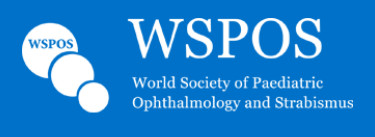Education
Case Report: Case 18
Case Presenters
Dr. E. Cumhur Sener, MD, obtained his medical degree from the Hacettepe University School of Medicine, Ankara, Turkey. He completed his residency at the Hacettepe University, Department of Ophthalmology in 1991. He was assigned as associate professor in 1995, and as clinical professor of ophthalmology from 2002-2014 at the same university. He is currently at private practice. He was involved in basic and clinical research at the Netherlands Ophthalmic Research Institute, Amsterdam, the Netherlands in 1993, and at the Johns Hopkins University Wilmer Eye Institute Pediatric Ophthalmology and Strabismus Department, Baltimore, USA in 1994. He served as faculty at the ORBIS project of Pediatric Ophthalmology and Strabismus, Chennei, India in 2002. He is specialized in strabismus (children and adult) and pediatric eye diseases. He has published, lectured and presented more than 100 original scientific research at the national and international ophthalmology meetings, and peer reviewed journals. He is the author of several chapters of textbooks and the monographs of “Şaşılık ve Tedavisi” (Strabismus and its Management) (2002), and “Çocuk Göz Hastalıkları ve Şaşılık” (Pediatric Ophthalmology and Strabismus) (2009). He is a member of the Turkish Ophthalmological Association, American Academy of Pediatric Ophthalmology and Strabismus (AAPOS), European Strabismus Association (ESA), and World Society for Pediatric Ophthalmology and Strabismus (WSPOS). He was the president of The Turkish Ophthalmological Association Strabismus division between 2009 and 2010.
Dr. Pinar Topcu Yilmaz, MD acquired her medical degree from Hacettepe University School of Medicine, Ankara, Turkey in 2002. She completed her ophthalmology residency at the same university (2007), which was followed by a Pediatric Ophthalmology and Strabismus Fellowship (AAPOS accredited) at the Wilmer Eye Institute, Johns Hopkins University, Baltimore, USA (2008-2009). She was assigned associate professor in 2019 at the Hacettepe University. She is a member of the Turkish Ophthalmological Association, American Academy of Pediatric Ophthalmology and Strabismus (AAPOS) and World Society for Pediatric Ophthalmology and Strabismus (WSPOS). She is currently at private practice with Dr Sener.
Drs. E. Cumhur Sener & Pinar Topcu Yilmaz sent us Case 18
Status: CASE CLOSED
Members’ Responses:
1) When our members were asked how they’d manage the case at this juncture?
11.11 % said they’d opt for a Monovertical Rectus Transposition, 5.56% choose to perform a Vertical Rectus Transposition, 5.56% said they’d go for a Vertical Rectus Transposition with cilliary vessel sparing, 27.78% said they’d prefer to perform a Vertical Rectus Transposition with augmentation sutures, 27.78% opted for Vertical Rectus Transposition, Nishida modification & 11.11% preferred to perform Additional surgery on the 12 mm recessed right MR, while the remaining 11.11% said they’d opt for some other procedure to manage the case at this juncture.
2) When they were asked whether they would consider additional surgery?
If so, what procedure would they opt for? While 11.11% of respondents preferred to perform a Simultaneous right LR plication, 66.67% would opt for a Simultaneous BTX-A injection to the right MR under general anesthesia (refuses topical anesthesia), the remaining 22.22% chose not to do anything for the time being (i.e. Leave alone). However none of our respondents (i.e. 0%) opted for any procedure other than those suggested by the authors.
3) When our members were asked How they’d manage the case now?
While 16.67% said they’d perform a Right MR advancement, the remianing 83.33% opted for a Left MR resection+LR recession. None of our respondents opted to perform a Removal of Augmentation sutures on VRT / a Left LR periosteal fixation / some other procedure.
.
Experts Opinion
1) This patient had a history of two previous surgeries in his only seeing RE. What is the risk of losing sight (the only seeing eye) because of ASI or endophthalmitis with a 3rd procedure?
2) Do you think an informed consent would prevent a law suit in case of a sight threatening complication?
3) Lateral rectus simple periost fixation did not totally eliminate abduction and the reinseriton to the sclera. In order to achieve complete reduction of the abduction, is resection and burying of the LR with Tenon’s sufficient? Is oblique muscle weakening essential in order to achieve such an effect?
4) How would you approach to the disfiguring difference of the motility pattern because of the longer and faster saccades of the left eye of this patient?
5) How would you compare the different transposition techniques in terms of efficiency and/or ease of revision?
Meenakshi Swaminathan

Dr. Virender Sachdeva is a consultant in Pediatric ophthalmology, strabismus and neuro-ophthalmology
at L. V. Prasad Eye Institute, GMRV Campus, Visakhapatnam, India. He underwent a fellowship in
comprehensive ophthalmology and pediatric ophthalmology at L. V. Prasad Eye Institute, Hyderabad and
has been working at the LVPEI GMRV campus as a faculty since 2008. He also pursued a clinical research
fellowship in Neuro-ophthalmology at the Emory University, Atlanta, USA. He has been actively involved
in the teaching and research pertaining in fields of pediatric ophthalmology, squint and neuro-
ophthalmology. His special areas of interest include amblyopia, complex strabismus, visual field
abnormalities, pupil abnormalities, Optic neuritis, IIH and Neuroimaging. He is concentrating on clinical
research in the newer therapies for amblyopia, atypical forms of optic neuritis, pediatric optic neuritis,
idiopathic intracranial hypertension, and hereditary optic neuropathies in Indian populations. Dr.
Sachdeva has been a peer reviewer for many indexed journals in ophthalmology such as BJO, AJO,
Ophthalmology, Indian Journal of Ophthalmology, International Journal of Ophthalmology and is the
section editor of the BMC Ophthalmology, for pediatric ophthalmology and Strabismus.
Dr. Meenakshi Swaminathan did her residency from the PGIMER, Chandigarh and the University of Louisville, Kentucky. She did her fellowship in Pediatric Ophthalmology at the University of Iowa. She works at Sankara Nethralaya, Chennai, India, which is a tertiary care teaching hospital which trains residents and fellows. She is also the Director of Academics for over a decade. She has been working with the ICO in conducting several Teachers in Ophthalmology programs both in India and other countries.
Mauro Goldchmit

Dr. Goldchmit is a Doctor of Medicine at the São Paulo Federal University at São Paulo, Brazil. He is also a Professor and Chief of the Strabismus Section at the CEMA Hospital at São Paulo, Brazil in addition to being an Executive-Director at the Strabos Institute in São Paulo, Brazil Mauro Goldchmit pursued his undergraduate education at the Santo Amaro Medical School, São
Paulo, Brazil form 1980-1986, followed by a Residency in Ophthalmology at Santa Casa de São Paulo at São Paulo, Brazil from 1987-1989. He then went on to do a Fellowship in Strabismus at the Santa Casa de São Paulo, São Paulo, Brazil in 1989, followed by Neuro-Ophthalmology Fellowship from São Paulo Federal University, São Paulo, Brazil in 1989. He subsequently went on to do a Pediatric Ophthalmology and Strabismus Fellowship at the Smith-Kettlewell Eye Research Institute, San Francisco, USA in 1990.
Dr. Goldchmit got his Master Degree in Ophthalmology from the São Paulo Federal University, São Paulo, Brazil in 1992, following which he acquired his Doctors Degree in Ophthalmology from the São Paulo Federal University, São Paulo, Brazil in 1997.
He was the President of the Brazilian Strabismological Society from 1997 – 1999 & the President of the Latin American Council of Ophthalmology from 1998 – 2000.
A paralytic strabismus, as there is an imbalance of innervational forces, by itself represents a particular challenge for the surgeon in terms of expectations of results to obtain single binocular vision in a wide visual field. This case is all the more complex because the patient presents with previous surgeries (two in this case) in the sound eye. The complexity in terms of what to do increases when there are no previous surgical reports available and we are facing a patient with an anomalous head position that needs to have a new procedure on the sound eye to correct his torticollis. Saying that, surgeons might differ in terms of approach to a complex case like this but there are some guidelines that must be followed and will be discussed in answering the author’s questions.
1) How would you manage the case at this juncture?
First and most important is to explain the whole scenario to the patient and family that the only way to correct his torticollis is operating on the sound eye with all the attendant risks that it may not be possible to have a perfect outcome and finally that he will get a secondary exotropia on the left eye that will need to be fixed later on.
Considering:
a) we don’t have information about what was done,
b) in order to correct the huge torticollis we have to operate on the only eye with vision and
c) the author has mentioned that there is a positive traction test indicating a tight right medial rectus that was found 12 mm from the limbus
My first approach would be to re-recess the tight right medial rectus as much as possible with no risk of overcorrection since we are dealing with a 6th nerve paralysis. All intraoperative tests (forced traction, spring-back balance forces) should be used to check the eye position under general anestesia. As the patient has a very large torticollis, the medial rectus recession alone will probably not solve the problem. Then you have to consider if and what was done to the other muscles. If the vertical muscles were not operated on, I would add a transposition of the temporal halves of the vertical rectus to the LR insertion.
2) Would you consider additional surgery? If so, what procedure would you opt for?
The author’s option was to perform vertical rectus transpositions with augmentation sutures. The point is that the tightness of the medial rectus was not addressed. If there was a residual esotropia after the procedure, I would perform a medial rectus re-recession at this moment with a risk of anterior segment ischemia near zero.
3) How would you manage the case now?
The procedure done on the right eye was able to correct the head turn but, with any type of surgery on the fixing eye the result will be a secondary exotropia. We observed on the photos and the vídeo a strong limitation of adduction that was not present before. As this is the result after one year it is not related to the BTX-A injection but due to the vertical rectus transposition with augmentation sutures and not to the previous medial rectus recession. If we decide to improve this adduction deficit we’ll cause a recurrent right esotropia and have a recurrence of the torticollis. Unfortunatelly this limitation is a price to be paid to eliminate the torticollis. As the patient / family don’t want further surgery on the fixing eye, I would perform a left recess-resection surgery.
4) This patient had a history of two previous surgeries in his only seeing RE. What is the risk of loosing sight (the only seeing eye) because of ASI or endophthalmitis with a 3rd procedure?
ASI is a rare complication described in the literature. Most of the cases are mild with good resolution. This was one of the reasons for choosing transposition of the temporal halves of the vertical rectus to preserve ciliary arteries (the author had tried with partial success to spare ciliary vessels). Maintaining the medial cilliary vessels from the vertical muscles and the one from the lateral rectus (medial rectus was already operated on), I would not worry about ASI in a young patient. Endophthalmitis should be considered, in my opinion, to have extremely low risk as any other strabismus procedure.
5) Do you think an informed consent would prevent a law suit in case of a sight threatening complication?
The Informed Consent is an ethical and legal requirement, mandatory prior to any medical procedure. Parents and patient must receive all information about the risks and possibility of complications involved, including an extremely clear explanation on the chances of permanent visual loss, as the case refers to a patient who effectively has a single eye.
This particular case has one aspect that brings extra legal issues, as the patient is a 14 years old teenager. This topic must be considered, as in some countries, patients between 11 and 17 years old, have the right to express their will, and that must be considered in the final decision. A recommendation would be that the consent should be obtained from both: patient and parents.
As the patient brings the willingness to be submitted to the surgery and the parents are also in agreement, they must be fully informed about the potential risks.
Physicians must be aware that even though all the elements required in an Informed Consent are fulfilled, the risk of malpractice lawsuits should always be considered, but a document written up meticulously will be a powerful preventive tool.
When specific ethical issues are involved, like in this case that the patient is under 18 years old, the recommendation to bring a psychologist into the process of obtaining the consent would be appropriate in some countries.
6) Lateral rectus simple periost fixation didnot totally eliminate abduction and the reinseriton to the sclera. In order to achieve complete reduction of the abduction, is resection and burying of the LR with Tenon’s sufficient? Is oblique muscle weakening essential in order to achieve such an effect?
I have no relevant experience to comment on this. I don’t think that inferior oblique weakening will be effective in correcting the residual exotropia. I would prefer a medial rectus resection.
7) How would you approach to the disfiguring difference of the motility pattern because of the longer and faster saccades of the left eye of this patient?
This will be more difficult as the larger and faster saccades of the left non-visual functioning eye is a result of the right eye horizontal limitation that creates those movements. A possible alternative is a resection of the medial rectus adding a posterior myopexy.
8) How would you compare the different transposition techniques in terms of efficiency and / or ease of revision?
There are several factors involved on a surgery revision and one that is not known is how much of scar and/or adhesion each patient will present. This might result in more or less difficulty for the surgeon to find the muscles and modify what was previously done. It is not just a matter of which technique was used.
Prof. Burton Kushner

Burt Kushner is an American pediatric ophthalmologist specializing in the diagnosis and treatment of strabismus. Kushner’s contributions include demonstration of improved visual fields of patients following strabismus surgery, elucidation of torsional contribution to patients with diplopia, corticosteroid treatment of periocular capillary hemangioma, and novel hypotheses on the mechanism of “overacting” extraocular muscles.
He is currently the Professor Emeritus in the Department of Ophthalmology & Visual Sciences of the University of Wisconsin, USA.
Professor Kushner will deliver the Strabismus Keynote Lecture on Saturday 3rd October 2020, his speech is titled “Forty-Five Years of Studying Intermittent Exotropia – What Have I learned?”
1) How would you manage the case at this juncture?
I choose G (other). Specifically, I would do a temporal transposition of the RSR with an augmentation suture, combined with intra-operative Botox injection of the RMR
2) Would you consider additional surgery? If so, what procedure would you opt for?
I choose B (Botox to the MR under general anaesthesia). The decision as to whether or not to do more surgery or leave alone should be driven by how acceptable the residual face turn is and how cosmetically acceptable the residual esotropia is. With 20-30 PD of esotropia, the face turn could be as small as 10 – 15 degrees, which might be acceptable. We are not told if the residual 20-30 PD of esotropia is in the primary position with his face straight, or in his preferred head posture. If it is in his preferred head posture, I would think this much esotropia would not be acceptable. But if it is only with his head straight, and he normally does not assume that position, we are dealing with a secondary deviation which may not be seen in daily life. But for the sake of discussion, I will assume the answer to the aforementioned items indicate that further surgery is needed. Depending on whether the 20-30 PD of esotropia is the deviation seen with his head turned, or only a secondary deviation with his head straight, I might scale back the dose of Botox. If the walking around deviation is smaller, and given that the RMR is 12mm from the limbus, my usual dose of Botox for 20-30 PD might overcorrect the deviation.
3) How would you manage the case now?
I choose E (other). The left XT is a secondary deviation driven by the limited adduction in the right. One needs to determine if the limited adduction is caused by restriction temporally in the right eye, or the right MR being crippled. One cannot do active force generation due to lack of cooperation. We are told the saccades OD are less than OS, but we are not really told the quality of the RMR saccades. Further, the video does not really show saccades into left gaze. But a visual assessment of the RMR saccades can shed light on this. Also, forced ductions should be done in the OR. Ideally, If there is temporal restriction OD, that needs to be addressed. If not, and if the RMR is crippled, it should be advanced.
4) This patient had a history of two previous surgeries in his only seeing RE. What is the risk of loosing sight (the only seeing eye) because of ASI or endophthalmitis with a 3rd procedure?
The risk of endophthalmitis is very very low, and should not be substantially increased as a result of prior surgery. The risk of ASI is also quite low in a child of this age, but it is worrisome enough to have concern in this essentially one-eyed patient. The actual risk is influenced by which muscles were operated previously, which is unknown, and which are to be operated upon now. If further surgery is on the same muscles that were operated before, I would not be concerned. If the planned surgery involves a 3rd or 4th rectus muscle, I would have enough concern to do a vessel sparing procedure. Since we do not know what was done before, this decision may have to be made intra-operatively. Also, iris angiography can be helpful pre-operatively in assessing the risk.
5) Do you think an informed consent would prevent a law suit in case of a sight threatening complication?
I do not know what the laws are in Turkey. But in the US, nothing can “prevent” a suit from occurring. The real question is if a suit has a chance of winning for the plaintiff. I would think that if consent was truly “informed” as to all the risks and likelihood of their occurring, the patient agrees to take the risks, and it is well documented, you should be safe. I would use a more detailed form than our routine generic informed consent form, be specific on it, and have the patient sign it.
6) Lateral rectus simple periost fixation didnot totally eliminate abduction and the reinseriton to the sclera.
In order to achieve complete reduction of the abduction, is resection and burying of the LR with Tenon’s sufficient? Is oblique muscle weakening essential in order to achieve such an effect? In my experience, periosteal fixation of the LR provides more weakening than a large resection and burying the LR. I presume in this case the issue was technical as usually one would not find a slip of the LR attaching to the globe after periosteal fixation. I have never simultaneously weakened the IO when I put the LR on the periosteum and would not think doing so is necessary. The IO’s abduction force vector is small in the primary position.
7) How would you approach to the disfiguring difference of the motility pattern because of the longer and faster saccades of the left eye of this patient?
There is no simple answer. In general, it is a very difficult situation when a patient fixates with an eye that has limited movements due to restriction or paresis. Operating on just the eye that shows the secondary deviation is limiting, as the eye will still show large deviations when the fixing eye moves toward its limited gaze field. So the general approach should be to do as much as possible to get the fixing eye to have improved ductions.
8) How would you compare the different transposition techniques in terms of efficiency and / or ease of revision?
It depends somewhat on if the MR is tight. If it is, any procedure that does not include loosening the MR will go down in efficacy.
That said, in order of decreasing power I would list (a) SR and IR to the LR with augmentation,
(b) SR to the LR with augmentation with MR weakening (Botox or recession).
About equal in effectiveness (c) i] SR to the LR without augmentation but with MR weakening, and about equal to (c) ii] SR to the LR with augmentation but not MR weakening.
(d) SR and IR to LR without augmentation.
The ease of revision depends on what you want to do. Revising or removing an augmentation suture is easier than revising a transposed muscle. Revising one transposed vertical rectus muscle is easier than revising two.

